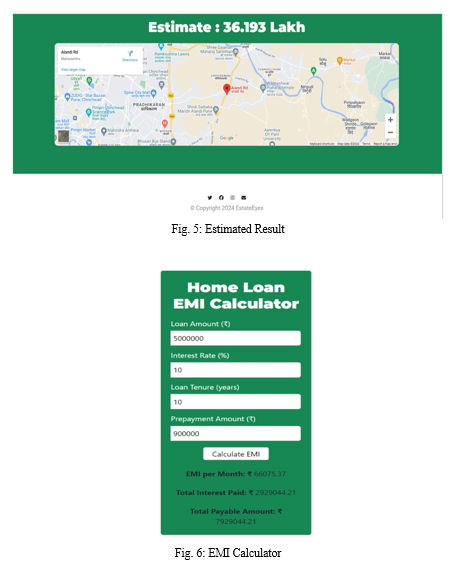Ijraset Journal For Research in Applied Science and Engineering Technology
- Home / Ijraset
- On This Page
- Abstract
- Introduction
- Conclusion
- References
- Copyright
Estate Eyes, Predicting Your Dream Homes Value
Authors: Prof. Dipali Mane, Akash Vishwakarma, Rohan Ghorpade, Vaishnavi Patil , Varad Pawale
DOI Link: https://doi.org/10.22214/ijraset.2024.62017
Certificate: View Certificate
Abstract
Real estate transactions are known for their complexity and uncertainty, which can make it challenging for both buyers and sellers to make informed decisions. Addressing this issue, a machine learning initiative called \'Estate Eyes: Predicting Your Dream Home\'s Value\' has been developed. This project utilizes a user-friendly web interface to collect essential property details and predict the approximate value of a user\'s ideal home. By integrating user-driven filters and a machine learning model, the platform simplifies the real estate process, reduces the information gap in the housing sector, and empowers users to confidently make informed decisions. The primary objective of this project is to enhance transparency, reduce uncertainty, and improve efficiency in real estate transactions.
Introduction
I. INTRODUCTION
The real estate market is a dynamic and multifaceted environment that demands informed decision-making for successful transactions. 'Estate Eyes: Predicting Your Dream Home's Value' represents an innovative machine learning (ML) project aimed at simplifying the process of valuing one's dream home. This initiative is centered around a user-friendly web interface that gathers essential property details, including location, size, and the number of bedrooms. Through the application of advanced ML techniques, the system provides precise predictions regarding the property's value, thereby enhancing transparency and operational efficiency within real estate transactions. The transformative potential of this system within the real estate industry stems from its emphasis on promoting transparency, equipping users with data-driven insights, and cultivating a community of knowledgeable homebuyers and sellers. By embracing a contemporary approach that leverages data for informed decision-making in property dealings, 'Estate Eyes' signals a paradigm shift in real estate towards a landscape where transparency and informed choices are not the exception but the standard practice.
A. Scope of the Project
- Assist investors in making informed decisions by predicting future property values based on various factors.
- Provide homeowners and real estate agents with estimates of property values for buying, selling, or refinancing purposes.
- Support city planners in understanding housing demand and guiding infrastructure development and zoning decisions.
- Evaluate the risk associated with mortgage lending or insurance underwriting by predicting property values.
II. RELATED WORK
The real estate market is vast and complex, with numerous factors influencing property prices. To simplify the process of predicting house prices, researchers have developed various models using machine learning and artificial intelligence techniques. One such model, proposed by Pei-Ying Wang et al. in [3], uses a deep learning model and heterogeneous data analysis with a joint self-attention mechanism to predict house prices accurately. This model considers factors such as public facilities and the surrounding environment to provide better prediction accuracy. Another study by Choujun Zhan et al. in [5] proposes using deep learning methods to predict housing prices in Taiwan. The authors found that a deep learning algorithm called CNN performed the best in predicting housing prices. This study can help inform interventions in the housing market. In addition, researchers have also explored the use of Google search data to predict housing price changes. A study by Nina Rizun and Anna Baj-rogowska in [4] found that analyzing Google search data can provide valuable insights into the real estate market and help predict housing price changes. On the other hand, some researchers have focused on using machine learning algorithms to predict house prices. For instance, a study by J. J. Wang et al. in [2] discusses using memristors in artificial neural networks to predict house prices in Boston. The researchers designed a 2-layer feed-forward neural network using memristors as synapses, and the weights of synapses can be adjusted online by the pulse voltage with the BP algorithm. The neural network can learn to predict the house price under training mode and successfully predict the house price in the predicting mode.
III. METHODOLOGY
A. Random Forest
Random Forest is an ensemble learning method that operates by constructing a multitude of decision trees during training and outputting the mode of the classes (classification) or mean prediction (regression) of the individual trees. It builds multiple decision trees and merges them together to get a more accurate and stable prediction. Each tree in the Random Forest is trained on a random subset of the training data and a random subset of features. This randomness helps to reduce overfitting and improve generalization performance. Random Forests are versatile and widely used in various applications due to their robustness and ability to handle high-dimensional data with complex relationships.
B. Gradient Boosting
Gradient Boosting is another ensemble learning technique that builds a strong model by sequentially adding weak learners (typically decision trees) to the ensemble. Unlike Random Forest, where trees are built independently, Gradient Boosting builds trees in a serial manner, where each new tree corrects errors made by the previous ones. It works by minimizing a loss function (e.g., mean squared error for regression problems) using gradient descent. Gradient Boosting is known for its high predictive accuracy and is particularly effective in handling structured/tabular data, making it popular in machine learning competitions and real-world applications.
C. Linear Regression
Linear Regression is a simple yet powerful supervised learning algorithm used for regression tasks. It models the relationship between a dependent variable (target) and one or more independent variables (features) by fitting a linear equation to observed data points. The goal is to find the best-fitting line (or hyperplane in higher dimensions) that minimizes the sum of the squared differences between the observed and predicted values. Linear Regression assumes a linear relationship between the input features and the target variable, making it interpretable and easy to implement. However, it may not capture complex nonlinear relationships present in the data, which can limit its effectiveness in certain scenarios.
D. Meta Model
The meta-model in this context refers to an ensemble learning technique known as stacking. Stacking combines multiple base models' predictions to build a more robust and accurate final prediction. In this setup, the base models are the Random Forest, Gradient Boosting, and Linear Regression models. The meta-model takes the predictions made by these base models as input features and learns how to combine them to make the final prediction. Stacking leverages the strengths of different models and can often outperform any individual base model by learning to correct their weaknesses. It is a powerful technique in machine learning competitions and has been shown to achieve state-of-the-art performance in various prediction tasks.
E. Stacked Algorithm Performance
Upon employing the stacking method to combine predictions from various algorithms, the resulting model demonstrates promising performance. Stacking merges the strengths of multiple individual models to enhance predictive capabilities. In this case, the stacked regression model achieves a Root Mean Squared Error (RMSE) of about 14.91, indicating a relatively small average deviation between predicted and actual values. Furthermore, the stacking model achieves a high coefficient of determination (R-squared) of approximately 0.957, indicating that around 95.7% of the variance in the dependent variable is explained by the ensemble of algorithms. This result underscores the effectiveness of stacking in improving predictive accuracy by leveraging the diverse perspectives offered by different models.




V. ACKNOWLEDGEMENT
We express our heartfelt gratitude to Professor Dipali Mane for her invaluable mentorship and support throughout this project. Her expertise and encouragement played a crucial role in shaping our academic journey. We sincerely appreciate her dedication and guidance, which have greatly contributed to our accomplishments.
Conclusion
In conclusion, this project focused on the prediction of house prices using machine learning algorithms, namely Random Forest, Gradient Boosting, and Linear Regression. Through rigorous implementation and analysis, valuable insights were gained into the efficacy of these algorithms in the real estate domain. The results showcased the strengths of each model, with Random Forest exhibiting robust predictive capabilities, Gradient Boosting providing nuanced improvements through iterative learning, and Linear Regression offering a baseline understanding of linear relationships. Moreover, the utilization of ensemble techniques, such as stacking, further enhanced predictive accuracy and demonstrated the potential for model fusion in tackling complex regression tasks. This study contributes to the understanding of machine learning methodologies in real-world applications and lays the groundwork for future research endeavors aimed at refining housing price prediction models. By leveraging the diverse perspectives and strengths of various algorithms, practitioners can better navigate the complexities of the real estate market and empower informed decision-making processes.
References
[1] Nor Hamizah Zulkifley, Shuzlina Abdul Rahman, Nor Hasbiah Ubaidullah, Ismail Ibrahim,\"House Price Prediction using a Machine Learning Model: A Survey of Literature,\" International Journal of Modern Education and Computer Science, vol. 10, January 18, 2021. [2] J. J. WANG, S. G. HU, X. T. ZHAN, Q. LUO, Q. YU, ZHEN LIU, T. P. CHEN, Y. YIN, SUMIO HOSAKA, AND Y. LIU, \"Predicting House Price with a Memristor-Based Artificial Neural Network,\" IEEE open-source journal, vol. 6, April 18, 2018. [3] PEI-YING WANG, CHIAO-TING CHEN, JAIN-WUN SU, TING-YUN WANG, AND SZU-HAO HUANG, \"Deep Learning Model for House Price Prediction Using Heterogeneous Data Analysis Along with Joint Self-Attention Mechanism,” IEEE open-source journal, vol. 16, April 15, 2021. [4] NINA RIZUN AND ANNA BAJ-ROGOWSKA,\"Can Web Search Queries Predict Prices Change on the Real Estate Market?\" IEEE open-source journal, vol.23, May 17, 2021. [5] Choujun Zhan, Zeqiong Wu, Yonglin Liu, Zefeng Xie, Wangling Chen,\"Housing prices prediction with deep learning: an application for the real estate market in Taiwan,\" IEEE open-source journal, vol. 6, 2020. [6] Bindu Sivasankar, Arun P. Ashok, Gouri Madhu, Fousiya S,\"House Price Prediction,\" International Journal of Computer Sciences and Engineering, Vol.8, Issue.7, July 2020. [7] G. Naga Satish, Ch. V. Raghavendran, M.D.Sugnana Rao, Ch.Srinivasulu,\"House Price Prediction Using Machine Learning,\" International Journal of Innovative Technology and Exploring Engineering, Vol. 8, Issue 9, July 2019. [8] ANAND G. RAWOOL, DATTATRAY V. ROGYE, SAINATH G. RANE, DR. VINAYK A., BHARADI,\"House Price Prediction Using Machine Learning,\" IRE Journals, vol. 4, issue 11, MAY 2021. [9] Siddhant Burse, Dhriti Anjaria, Hrishikesh Balaji,\"Housing Price Prediction Using Linear Regression,\" Journal of Emerging Technologies and Innovative Research, vol. 4, Issue 10, October 2021. [10] Manoj VN, J Yugesh, Girish NL, Madhusudhan Reddy,\"HOUSE PRICE PREDICTION USING LINEAR REGRESSION,\" International Research Journal of Modernization in Engineering Technology and Science, vol. 5, issue 4, April 2023. [11] G S Madhumitha, D. Beulah David,\"ENHANCING ACCURACY IN HOUSE PRICE PREDICTION USING NOVEL LINEAR REGRESSION COMPARED WITH DECISION TREE,\" Eur. Chem. Bullsss., vol. 8, March 2023. [12] Adyan Nur Alfiyatin, Hilman Taufiq, Ruth Ema Febrita, Wayan Firdaus Mahmudy,\"Modeling House Price Prediction using Regression Analysis and Particle Swarm Optimization,” International Journal of Advanced Computer Science and Applications, vol. 4, October 2017. [13] Pushpak Lawhale, Yash Ramatkar, Shrikant Dakhore, Manshri Gumble, Aishwarya Tawlare, Ms. Yugandhara A. Thakare,\"House Price Prediction using Machine Learning,\" International Journal of Advanced Research in Science, Communication and Technology, vol. 10, Issue 7, May 2022. [14] Hardi Joshi, Saket Swarndeep,\"A Comparative Study on House Price Prediction using Machine Learning,\" International Research Journal of Engineering and Technology, vol. 9, Issue 11, November 2022. [15] Maida Ahtesham, Narmeen Zakaria Bawany, Kiran Fatima,\"House Price Prediction using Machine Learning Algorithm - The Case of Karachi City, Pakistan,\" International Arab Conference on Information Technology, vol. 5, 2020.
Copyright
Copyright © 2024 Prof. Dipali Mane, Akash Vishwakarma, Rohan Ghorpade, Vaishnavi Patil , Varad Pawale. This is an open access article distributed under the Creative Commons Attribution License, which permits unrestricted use, distribution, and reproduction in any medium, provided the original work is properly cited.

Download Paper
Paper Id : IJRASET62017
Publish Date : 2024-05-12
ISSN : 2321-9653
Publisher Name : IJRASET
DOI Link : Click Here
 Submit Paper Online
Submit Paper Online

